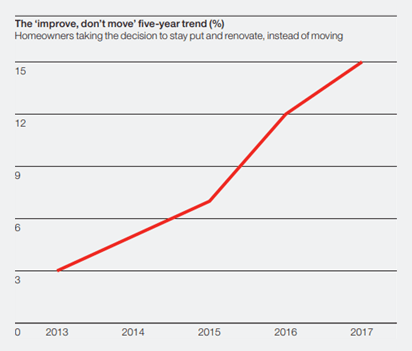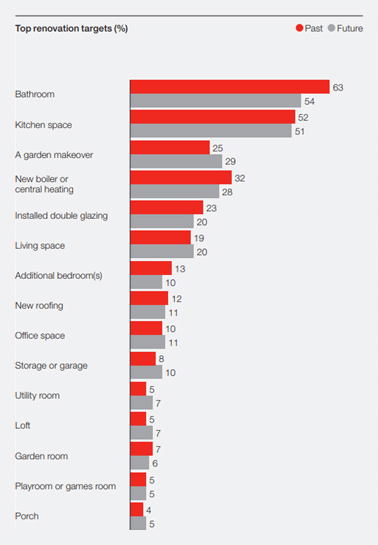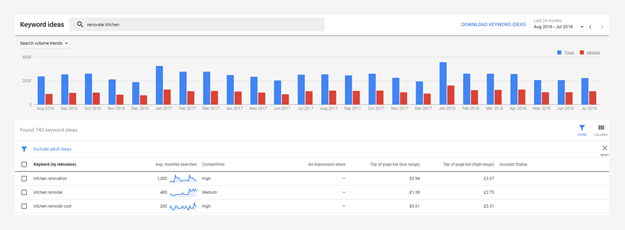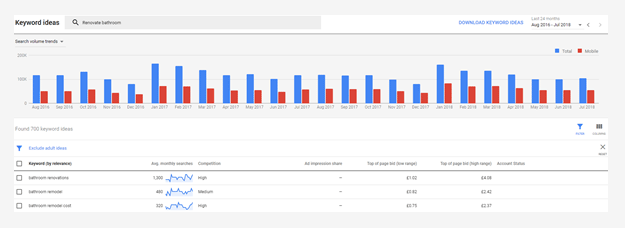Home Improvement Trends, Statistic & Marketing Ideas 2018
While UK estate agents suffer with homeowners increasingly staying put – what the Council of Mortgage lenders dub the “missing movers”1 – it should be a prime time for the home improvement market. In fact, according to recent research2 , the “improve, don’t move” trend has grown steadily over the last five years, from 3% of households to 15% – representing more than four million UK households investing in their homes.
That’s 4 million potential customers for home improvement marketers to target. Good news, right?

Struggling Giants
On the flipside, traditional home improvement giants have been taking a battering. Homebase has been lurching towards administration after the disastrous takeover by Wesfarmers, while B&Q reported a significant fall in sales in the summer of 2017.
The key irony is that B&Q suffered from a perception of low-quality products, relative high pricing and declining 3 while Homebase’s Australian owners tried to turn Homebase into B&Q by removing more upmarket ranges and slashing prices4.
The lesson from those two brands, as is true of all marketing, is that brands needs to offer their customers the appropriate combination of product, price and service to earn a potential customer’s trust – and this is something digital marketing can support.

Digital marketing tip 1:
Build trust with a comprehensive review strategy that includes service-level reviews on Google, onsite product-level reviews, case studies and testimonials.
Digital marketing tip 2:
Create content that demonstrates your expertise, either for your own site or for third-party sites and bloggers. Make sure to put a personal name to the content with a solid bio – this helps build your personal brand for people wanting to talk to you and follows Google’s latest quality guidelines that instruct its checkers to look at the reputation of content creators.
Homeowners Are Making Their Current House Their “Dream Home”
While bathrooms are still the number one renovation project, with 54% of homeowners either currently undertaking an update or planning one, the kitchen is not far behind at 51%. In other words, that’s 2 million homeowners looking for kitchens and, moreover, plans for kitchen projects have stayed stable against the past, while the bathroom is in decline.

Other growth areas in plans, such as loft extensions, basement conversions and creating additional living space all reflect a pattern – today’s home improvers are committing to these projects to improve their quality of life and enjoy their home as their family and circumstances change. It is not just about increasing value for a sale; it is about creating a dream home5.
However, with estate agents reporting new kitchens typically add 5.5% to a property’s value – and can add as much 10% – kitchen projects can tick multiple boxes for a homeowner.
Digital marketing tip 3:
Understand your customers’ needs and pitch your content marketing and ads to their story. Where once it was about value, now it’s about satisfaction with the current home and all its flaws. If magazines show the unattainable dream, be the trusted voice of reason with content like “small kitchen ideas” (9,900 monthly UK searches) or “narrow kitchen ideas” (390 monthly UK searches).
With Greater Investments Come Greater Opportunities
With renovators reporting an average budget of £16,100 per project and 18% planning spends over £25,000, there’s a lot to compete for. Within the kitchen market alone, luxury kitchens – defined as projects where the total budget would be around £40,000 – make up 32% of the total kitchen markets spend with a prediction that this segment will remain buoyant over the coming years as wealthy households tend to remain stable even in times of economic downturn.
Unpacking that £40,000 budget further reveals all the home improvement providers who can benefit from one project as it must cover domestic appliances, tiling, heating, flooring, fitting, decorating and any structural adjustments to reshape the room.
When we factor in single-storey extensions, for which 75,000 planning applications were granted in 20166 , we can also learn that many of these feature the installation of a new kitchen, as well as open plan living areas such as combined kitchen diners.
As such, a potential customer’s kitchen project takes us quite a long way from just cabinets and countertops to something that could provide new work for plumbers, builders, electrical stores, painters, decorators, heating engineers, door and window fitters, brick layers, electricians, furniture suppliers and more.

This becomes even more attractive looking at the ‘stratospheric’ sub-section of the kitchen market with budgets over £75,000 and a buyer seeking the perfect, showcase room at any price. However, this is still very much a niche and should be understood as being a tiny and intensely competitive part of the market, much like London’s iceberg basements that have received so much press coverage despite representing a fraction of the UK’s basement work.
Digital marketing tip 4:
Consider your service in the scope of wider projects and address that on your site. For example, plumbers could create content around “underfloor heating for kitchens” (210 UK monthly searches) while glaziers might consider “bifold doors for kitchen extensions” (30 UK monthly searches). Ensure your content has a strong call to action and consider remarketing to keep serving relevant messages that bring audiences back to you.
So, Who Is This Audience?
While TV might have us imagine young homeowners, tackling their first wreck of a property to turn a bargain into a beauty, the Office for National Statistics family spending figures reveal that the big spenders are those between 50 and 647 .

With the rate of UK home ownership among 20-to-29-year-olds having declined from 50% in 1993 to only 8 , this should come as little surprise, but it is an important targeting factor for a home improvement marketer to bear in mind.
In terms of location, the key drivers for the “improve, don’t move” trend are higher - and growing - property prices, land prices and stock availability9 . While London remains the home improvement hub, it is experiencing an overall decline as planning projects fall across most boroughs. Meanwhile, the trend for leaving London to own a larger home is fuelling growth and driving up prices in the districts around London, with Three Rivers, Brentwood and the Mole Valley typical of affluent districts on a home improvement kick.
Outside of the South East, the North West has emerged as a new home improvement hotspot, with healthy growth in activity in the North East and Yorkshire and Humber regions. This trend is supported by the family spending data, which indicates a significant increase in the figures being invested in home improvement in these regions.
Digital marketing tip 5:
With an older audience as the target, any social media advertising would be best on Facebook where reach and engagement is significantly higher than on platforms like Instagram, which are popular with younger audiences. When building your target audience, make sure to overlay relevant life events and interests to increase your chances of reaching the right potential customers, building your creative around their “dream home” story.
Digital marketing tip 6:
Make sure your local SEO is up to scratch if you are a local business and follow our advice for getting the most out of Google My Business’ new features to communicate offers and helpful content.
When Do We Reach Them?
On a national level, everything we’ve discussed is clearly reflected in the search trends, where we can see search volume for “sell my house” on the decline over the last two years, while “renovate kitchen” remains buoyant year-on-year and “renovate bathroom” has had small declines year-on-year but generally remains strong.



While the detail of local search volumes is beyond the scope here, even small investigations show interesting trends. While the London basement bubble clearly having peaked in 2016, leaving London-centric basement companies in a tougher market than the media might have you believe, interest in kitchen improvements in West Yorkshire is growing and staying strong:


Across all these terms, we can see a few key points in common. Firstly, whatever the project, January is when most people are thinking about undertaking it. This is when home improvement marketers must be prepared with a full-scale integrated digital marketing campaign promoting suitable offers to secure customers.
The next few months remain strong, with the first half of the year generally providing ample opportunities to attract people who are continuing their research or perhaps may feel inspired after missing out on January sales deals from the major home improvement brands.
After a lull in summer, September is revealed as the last big opportunity for engaging customers before the shorter days, bad weather and Christmas turn people away from home improvement to other considerations. This wouldn’t suggest pausing any marketing activity though, just be aware of what your audience may be focused on – and that December’s aspirational conversations and New Year’s resolutions are January’s search terms.
Digital marketing tip 7:
Use keyword research to not just identify your ideal target keywords for organic and paid search but to identify the locations where search volumes are increasing. Your traditional territories may no longer be as lucrative, especially in London, while new opportunities may be opening up.
Digital marketing tip 8:
While your organic search activity should be year-round, any paid search management should be built around seasonal budgets with peaks in spring and autumn. The right activity in December could also make you front of mind for the new year.
For personalised advice on digital marketing for any home improvement service, book us in for a free digital strategy session where we can discuss your goals, target audiences and search opportunities.
Follow my contributions to the blog to find out more about marketing in a digital world, or sign up to the ThoughtShift Guest List, our monthly email, to keep up-to-date on all our latest guides, advice and blog posts.
Cited resources
- https://www.cml.org.uk/documents/20170630-cml-missing-movers-research-report/7738-cml-missing-movers-a4-jc-v4-3-.pdf
- https://www.hiscox.co.uk/sites/uk/files/documents/2018-03/Hiscox_renovations_extensions_report_2018.pdf
- https://www.euromonitor.com/home-improvement-in-the-united-kingdom/report
- http://www.insightdiy.co.uk/articles/wesfarmers-wrecked-homebase--australian-financial-review/1052.htm
- https://trend-monitor.co.uk/luxury-kitchen-uk-market-2017
- https://www.amaresearch.co.uk/products/home-extensions-2017
- https://www.barbour-abi.com/wp-content/uploads/2018/04/Home-Improvers-of-Great-Britain-2018-report.pdf
- https://www.theguardian.com/commentisfree/2018/feb/15/generation-rent-housing-crisis-buy-to-let-first-time-buyers
- https://www.ribaj.com/intelligence/market-analysis-building-industry-construction
Other resources:
- https://www.theguardian.com/money/2017/aug/23/underground-basements-halifax-loft-conversions-extend-properties
- https://www.theguardian.com/money/2017/aug/23/underground-basements-halifax-loft-conversions-extend-properties
- https://assets.kpmg.com/content/dam/kpmg/uk/pdf/2018/01/kpmg-annual-retail-survey-2018.pdf
- http://phpdonline.co.uk/features/kitchen-trends-2017/
